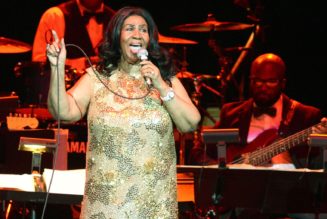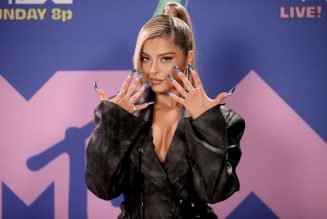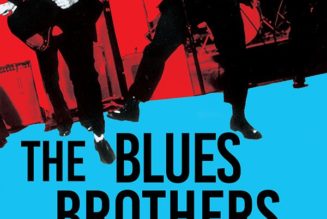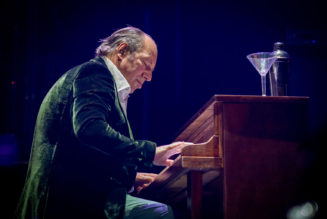By Gina Marinelli
As far as transformative style moments in teen-movie history go, few compare to the image of Sandy emerging from a crowd of Rydell High students in the final scene of Grease. Even before delivering her iconic line — “Tell me about it, stud” — it’s obvious she’s broken from her otherwise squeaky-clean reputation. It’s the big hair, the lit cigarette, and where Sandy’s demure cardigan sweater once sat, it’s the black leather moto jacket. The garment acts as a symbol of rebellion, just as it has on countless other film and TV characters for decades, even as definitions of and motives for resistance have changed. Take, for example, the timely flick, Moxie.
Netflix’s new original movie stars Hadley Robinson as Vivian Carter, a quiet high school student who anonymously starts a feminist revolution among her peers. Her actions are ignited by her school’s toxic culture — including double-standard dress codes, transphobic casting for the school musical, and a sexist, hot-or-not-style list compiled by male athletes. But her protest method of choice comes straight from ’90s punk culture and, by association, her mother.
Played by Amy Poehler, who also directed Moxie, Vivian’s mom Lisa is a former member of Riot Grrrl, the underground punk-rock feminist movement that led to the emergence of bands such as Bikini Kill, Sleater-Kinney, Heavens to Betsey, and Le Tigre. When Vivian comes across her mother’s collection of old zines, photos, and a worn-in leather jacket covered in pins (both safety and band memorabilia), it sparks something within herself as she finds a way to take a stand for her community. Thus, the Moxie zine is born, her own unabashed response to sexism and call to action among her classmates, compiled in a collage-style pamphlet.
 Colleen Hayes/Netflix
Colleen Hayes/Netflix“The leather jacket is completely symbolic, and when she chooses to wear it, she’s going into battle in armor,” says Robinson of her character, though it is also a keen description of the garment’s genesis. Its earliest use was in military wear at the start of the 20th century, including flight jackets for the U.S. Army. It wasn’t until 1928 that raincoat maker Irving Schott used leather to create the wide-collar, multi-zipper, belted-at-the-bottom moto style as we know it today. While the look circulated as the uniform of rebels in the decades following, made famous on figures like James Dean or The Ramones, it became mainstream in the ’90s as a fashion trend seen on models, actors, and teens everywhere. “You see a lot of men in different movies wear leather jackets — Brad Pitt in Fight Club, Tom Cruise in Top Gun, Harrison Ford in Indiana Jones — and it’s really cool to see a young girl put on this symbol of armor, and going into battle in her own way.”
Of course, other characters besides Vivian (often also white, blonde, and high-school-age women) have gone through a transformative life experience whilst wearing clothing with an edgy, tough, or cool reputation. In addition to Grease, there was 2020’s horror film Freaky in which Kathryn Newton’s Millie dons a red leather jacket after Vince Vaughn’s gruesome slasher, The Butcher, has occupied her physical body in a bizarre swap. Back in 1992’s Buffy The Vampire Slayer, the lead character played by Kristy Swanson dons a prom dress and biker jacket as she switches from slow dancing to staking the undead. Even Tayor Momsen’s Jenny Humphrey in Gossip Girl adopted leather jackets into her wardrobe in later seasons as she embraced the rebellious side of Little J. Moxie noticeably takes a nuanced, more gradual approach to this wardrobe addition throughout the film.
Vivian’s personality doesn’t flip like a switch when discovering her mother’s old jacket; she only wears it “when she starts to feel her feminine power,” explains costume designer Kirston Leigh Mann. We see Vivian first trying it on at home as Bikini Kill’s “Rebel Girl” plays in the background. She later wears it to a football game following a sweet, but also steamy, backseat date with her love interest, Seth, played by Nico Hiraga. When Vivian learns of a fellow student’s sexual assault, she sneaks to the school at night in her leather jacket to deface its front steps with red paint. And when she organizes a student walkout the very next day, she reveals herself to be Moxie with the now paint-stained jacket on her back. “It’s so much her mother’s [jacket] and by the end, with the little bit of red on the sleeves, she’s made it her own through the actions she’s taken,” says Robinson.
 Colleen Hayes/Netflix
Colleen Hayes/NetflixIn many ways, Moxie advances beyond teen-movie clichés of the ’90s or ’00s. The star jock (Patrick Schwarzenegger) is the obvious and unlikable antagonist. The student body is diverse. Girls aren’t pitted against each other but actively band together with a common interest. Then why does the leather jacket stay? “It still holds that power,” says Mann, who looked to punk icons such as Courtney Love, Kim Gordon, and Patti Smith for style inspiration for this project. “It breaks you free from a certain norm. Even though there are now slick leather jackets, and business-lady leather jackets, and rich-lady leather jackets, does it still hold the same kind of power as it did for Sandy in Grease? I don’t know. It’s how you wear it and how you feel in it. Vivian felt empowered in it.”
Mann also shares that Moxie’s costumes are a vehicle to move the story forward, not a sweeping use of symbolism to capture an entire social justice movement. After all, while Vivian may be the story’s lead, there are other characters who stand more firmly in their power from the start. Lucy (Alycia Pascual-Peña) is a newly transferred student who becomes friends with Vivian. “If you keep your head down, he’ll move on and bother somebody else,” Vivian says to Lucy, offering what she thinks is helpful guidance when Schwarzenegger’s character Mitchell harasses her. “Thanks for the advice, but I’m going to keep my head up. High,” Lucy confidently replies.
“She represents so much because she is empowered throughout the movie,” says Mann, who styles Lucy in ripped jeans and tights, layers of thick chain necklaces, and bomber jackets — though, for the record, not made of leather. “She’s the driving force in some ways. She was her own person, she wasn’t referencing anyone else.”
Maybe this explains why the power of a leather moto jacket continues to flourish in stories like this one, in stories of teen girls themselves. It’s a loaded garment that encompasses the past — be it Riot Grrrl or rockabilly — and it’s a tool for the character to find their truest self, instead of suggesting they’ve reached a final destination. “It’s not showing who she is,” says Robinson of her character. “By the end, it’s still a work in progress. It takes a long time to figure out who you really are but, in the process of wearing this jacket, it’s an exploration.”










